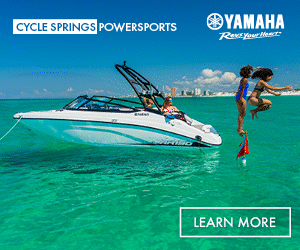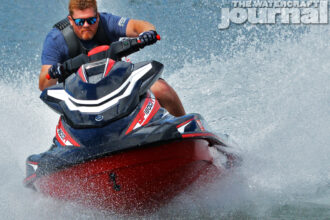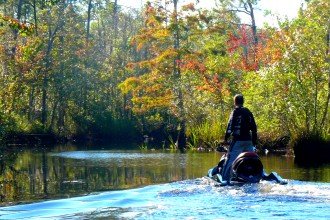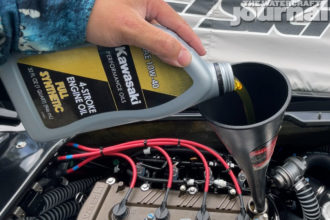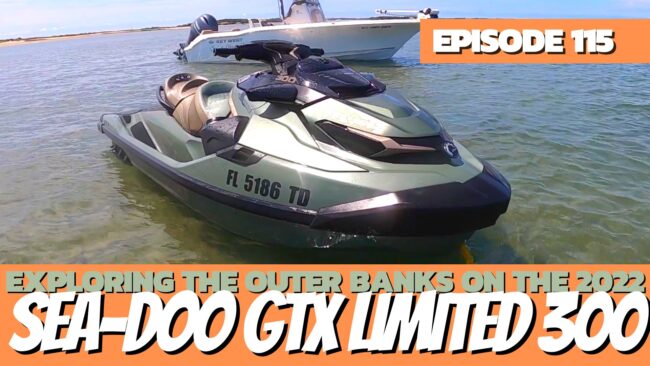
Easily one of the best rides I had been on was exploring Pamlico Sound and Cape Hatteras. That was waaay back in 2008, so the fog of memory has glossed over the unrelenting beating we took riding from Cedar Point to Ocracoke Island. I can certainly recall encountering brutal conditions as we passed the inlet, but the sting of saltwater in my eyes and aching in my joints has all but vanished over the years.
So when the opportunity to return to North Carolina’s Intracoastal Waterway arose, I couldn’t say no. Unlike the first trip, which was planned and paid for by Kawasaki’s media group, this week would be at our own leisure. This was to be a family trip. While the wife and two youngest kids were gonna ride on Uncle Ted’s 21-foot center console, my oldest would join me on the Sea-Doo.

I had picked up a 2022 Sea-Doo GTX Limited 300 (opted in premium Sage Green Metallic – for an added $300) only two weeks earlier and frankly, had only been out on it twice before leaving; apart from the standard-equipped Tech Package, everything else about it was old hat. Four years of testing and loaners has provided me plenty of seat time with the platform and all of its ins and outs.
The GTX in its current form was first introduced as a 2018 model. It’s what BRP calls its “ST3” platform and marries several unique attributes together to make a very unusual machine. Prior to launching the new design, Sea-Doo had its Fish Pro ready to release the next model year, so certain characteristics needed to be baked into the crust; namely the utmost in watercraft stability at static and low speeds for fishing.

Equally, the ST3 needed to accommodate the Wake Pro models, so a large rear platform with an integrated LinQ accessory system and ski pylon mount was designed, as well as deep, open footwells (again for the Fish Pro). The traditional bow storage was relocated to a large 25.3-gallon center storage tub, accessible from a seated position. Lastly, as it would serve the RXT-X, the sporty ErgoLock seat from the RXP-X was adapted as well.
Introduced in 2022, the aforementioned Tech Package equips the GTX Limited 300 with a full-color 7.8-inch display, chocked full of smart phone integration. Synced via Bluetooth, USB and the BRP GO! smartphone app, riders can play music, monitor the weather, and use GPS navigation. At each flank is a 50W waterproof speaker (100W total) that integrates the BRP Bluetooth Premium Audio System to your device.

Of course, beneath the two-tone, stitched-and-piped seat is the 1630 ACE 3-cylinder four-stroke producing 300-horsepower at just over 8,000rpm – the same powerplant that powers the sporty RXT-X 300 and race-ready RXP-X 300. Finally, the GTX’s $18,299 MSRP also includes the center storage bin organizer mesh net divider, padded knee coves, and all-weather PWC cover totaling out the Limited package.
We set up camp in Cape Carteret, just inland from Emerald Isle. After visiting the historic Fort Macon pre-Civil War fort the day before, we set in at Beaufort and journeyed past the US Coast Guard Sector Field Office before carrying on beyond the inlet, tracing the shoreline of Shackleford Banks. The Beaufort Inlet feeds the Back Sound, which we discovered was an undulating labyrinth of ever-changing shoals and sandbars that change with the ebb and flow of the tide.
At no time was I more grateful for the onboard depth sounder continually chiming as the sea floor rose to meet our hull. Equipped with this in-dash feature and a far more shallow draft than the center console boat, we let the Sea-Doo lead the path forward. Channel markers are regularly relocated by the Coast Guard to give boaters the deepest route through the sound, which at times, was less than 9-feet deep.
We arrived at Cape Lookout, the outward-most tip of a J-hooked island made famous by pirates Edward “Blackbeard” Teach, Stede “Royal James” Bonnet and Anne Bonny. The cape is known mainly for its iconic black-and-white checkered lighthouse, earning it its name. We avoided some high-rising shoals and anchored over 50 yards from shore. The younger kids dug for shells as we prepared sandwiches and cooled down with some cold drinks.

I had looped the end of my Sanddocker anchor to the GTX’s bow eye and watched as the changing (and quickly receding) tide pulled the Sea-Doo opposite of where we anchored. Concerned, I hustled from shore and began dragging the ski into deeper water. The tide was quickly going out and unless we wanted to camp over night, we needed to get moving, so we collapsed the EZ-Up and began loading up the boat.
Shackleford – like many of the outer banks – are home to wild native horses. Believed to be descendants of abandoned Spanish horses left to graze and populate the Carolina coastline, these horses crossed over on long-eroded isthmuses and remain on these grassy barrier islands. Unfazed by gawking spectators, these horses saunter up to the shoreline to nibble on lush salt grass and bullrush.

From Cape Lookout, we rode the deepest part of the channel to Hawkers Island. It was here where boat traffic picked up, and together with the afternoon’s Atlantic gusts and outgoing tide, the GTX’s hull began acting up. Despite Sea-Doo’s claims, the ST3 is not a “Deep-V” hull nor a superior offshore/rough water design. In reality, it’s quite the dramatic opposite.
What deceives most of the uninitiated as it being a “Deep-V” hull is the pronounced prow. At midships, the ST3 is demonstrably flat, smoothing out to a single-digit deadrise, giving the hull it’s characteristic stability at static-to-slow speeds. The smooth bottom attributes to the ST3’s top speed numbers, but that is in purely glassy conditions.
In mild chop or even in tracking through the wakes of other watercraft, the ST3 wanders unpredictably. In larger sea state conditions and/or elevated speeds, this bow hunting can become precarious to the novice rider – as it requires a tremendous amount of rider input (steering) to keep it tracking true.
Over time, I’ve come to find the ST3 is best suited for flat-water conditions at best. Even professional racers have abandoned the hull for the more manageable T3R hull of the RXP-X. But as noted, it’s not all bad. The ST3 is tremendously stable at slow speeds and provides an impeccably dry ride.

This is due to the bow’s shape that fans into deep, concave coves. By directing its forward wake outward in an unfurling arc, it makes for a far drier ride than a true Deep-V hull, which splits and sprays its wake upward. At low speeds, the ST3’s bow creates a roiling cushion that softens its ride in No Wake Zones.
So again to recap: the Sea-Doo sprays its wake out, while others spray up. It’s that simple.
Of course, the biggest appeal of the GTX and all ST3-based Sea-Doos is the deck design. The Sea-Doo sports a low-slung, handsome shape that is angular as it is masculine. The 5-way adjustable tilt steering is seemingly perfectly placed for most riders of any height and takes the 7.8-inch digital dashboard with it as it pivots up and down for maximum visibility.
And the GTX features both Sea-Doo’s pioneering Intelligent Brake & Reverse system as well as its Intelligent Debris Free system, which electronically reverses the thrust of the impeller, surging a pulse of thrust forward to purge the intake grate of any debris clogging the intake grate – like grass or seaweed.
The handlebars aren’t set too wide, with large, easy-to-navigate buttons that remain some of the most responsive in the industry. The winged “palm rest” handgrips support the wrist to reduce the fatigue felt by riders after a long day on the water. Navigating the pages of the Sea-Doo’s split screen dashboard is limited while at speed, but other functions like changing dashboard background colors and tracking fuel consumption and trip hours is a snap.
Unfortunately, the premier functions found only with the Tech Package and available through the BRP GO! app are excruciatingly frustrating – particularly for those less tech savvy. The process of syncing one’s smartphone to the GTX requires logging a new profile into the dashboard. Then, it must be synced via Bluetooth through your phone’s Bluetooth settings page. Once completed, the Sea-Doo will pair with your phone.
Yet, that is solely for using the sound system separate of the Tech Package, which will not allow you to control tracks and volume through the handlebar toggles. If you choose to control your playlist through the dash and handlebar controls, the phone must be continually tethered through an approved USB cord (that is, if you have an Apple iPhone) with the BRP GO! app left “open”.

It will automatically sign out if the phone goes into “Driving” mode or if the cord wiggles enough to break the link. Moreover, the BRP GO! app requires a solid data signal or too, will automatically sign out; and needless to say, in many locations outside of highly populated areas, such a usable signal of any magnitude is nowhere to be found. This lack of signal also will keep you from accessing your music library if its stored on the cloud, so make sure you’ve got a song list downloaded to your phone if you simply cannot enjoy the outdoors without added stimulation.
The glove box is another pinch point. The glove box cannot accommodate most modern full-sized phones – particularly larger Androids. With the BRP GO! app requiring the phone to be plugged in to the USB port at all times, the watertight door cannot be latched, as the phone must sit atop it. This leaves your phone subject to getting wet as the glove box door doesn’t close fully with the phone outside of its waterproof pocket.
All of that not withstanding, the shining jewel of the GTX is its overall comfort. The narrowed Ergolock seat, deep saddle and low-backed bolsters are comfortable, even for a taller rider. Passengers are entreated with similar cushioning and large handrails at the rear passenger’s sides. Sadly, without a glove box of any usable size, drinks or sunscreen must be kept within the center storage bin, which cannot be accessed easily while underway.
After idling through Taylor Creek, which separates Carrot Island from Beaufort, we pulled the boat and GTX up the ramp and enjoyed the evening after a full day on the water. The next morning, we put in closer to home base and sped southwest toward Hammocks Beach and Bogue Inlet. There we played on the beach and listened to the marine base fire off artillery rounds (no joke) in the distance.
With some time to spend and plenty of super unleaded in the 18.5-gallon fuel tank, I with my 12-year-old behind me, sped off to play in the incoming Atlantic surf. We rapped the throttle and launched gleefully over the white caps. Jumping surf is a dangerous game that is discouraged by BRP per the owner’s manual, and for good cause. While we didn’t press our luck too far, we did dislodge a GoPro camera from its mount (we found it bobbing on its bright orange float seconds later thankfully).
During this little jaunt in the surf, we did note one more peccadillo with the GTX Limited: the Sage Metallic paint is striking in person (particularly when the sun hits it just right); but boy, is it wholly invisible out on the open ocean. Were it not for my bright red Slippery Array Neo life vest and matching UV-blocking jersey, we would be lost to anyone searching for us.
The rest of the morning was spent tracing the shoreline, carefully navigating around shallows and sandbars, and pinning the supercharged Rotax when I encountered a rare patch of glass. On our journey back to the ramp, we happened upon a pair of dolphin – a mother and a calf – swimming up the Intracoastal. It was my daughters’ first time seeing dolphins in the wild, so we stopped the engines and let the current take us with it, hoping for a closer look.
As noon bled into afternoon, we returned back to the launch ramp and drove back to camp. The Sea-Doo served us well and provided plenty of smiles, but as far as a serviceable review, I found myself struggling with a near 50/50 split of praises and criticisms:

Given the hours our loaner carried, many of its panels (as well as the speakers), had begun to loosen and audibly chattered even on mildly bumpy water. Equally, even though our time on the rough, open seas were minimal at best, I found salt deposits inside of the center storage, glove box and engine compartment.
The glove box, the need for the smartphone to be plugged in for the app to function, and the interface itself is egregious, enough for me to suggest totally avoiding the frustration altogether. Too often we become so attached to new conveniences that we wonder how we could ever have lived before without them. In this case, if you can purchase a Sea-Doo without these contrivances, do it.
Most importantly, the ST3 hull is problematic. It wanders – oftentimes erratically – in chop, teeters to one side or another when not at plane (below 35mph), and has been shown to wholly ignore steering input in tight corners – sometimes putting its pilot in precarious situations. It’s really something I cannot in good conscience omit from this review.
All that being said, there is a great deal to praise the 2022 Sea-Doo GTX Limited 300 for, and hope that we’ve adequately listed those attributes here as well. Although it’s meant to offer the consumer the utmost in luxury and premier features, the GTX Limited 300 falls just a tad short, delivering more sizzle than steak. While other models offer similar comfort with greater performance, superior rough water tracking and more storage, none do all simultaneously. And that is why the GTX Limited 300 is the top tier machine of BRP’s watercraft lineup.






































